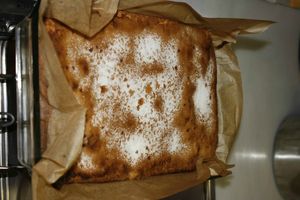Coca de llanda / Bizcocho de lata / Tin cake / Blechkuchen
Para un molde rectangular de horno con 2-3 cm de altura
3 huevos, 1 vaso de aceite de oliva (no extra virgen), 2 vasos de leche, 2 vasos de azúcar (vienen a ser 600 g), 3 vasos de harina (450 g - 475 g), 3 sobres de gaseosa (litines de toda la vida) o gasificante de repostería (Mercadona/Hacendado lo llama así), corteza de 1 limón rallada.
Azúcar para la costra. Para que haga costra, el grosor del azúcar debe ser como de 1 cristal (de los del azúcar)
Mientras se calienta el horno a unos 150 C. Si no váis a usar papel de hornear (o el reutilizable de silicona), untar el molde con aceite y espoloverar con harina.
Batir los huevos como para tortilla. Añadir los demás ingredientes y mezclar bien sin grumos. Yo tamizo / cuelo la harina.
Como se aprende de los errores, las gaseosas es mejor añadirlas a la harina que a los ingredientes líquidos. :-D
Verter la mezcla en el molde. Yo uso papel de hornear para recubrir el molde, si no, impregnar con aceite y harina. Debe quedar altura suficiente como para que suba la masa (1/2 cm). Si no, caera masa al suelo del horno y puede quemarse.
Espolvorear una capa de azúcar sobre la mezcla. En el horno se fundirá y hará "costra".
Tras 3/4 de hora, subir el horno a unos 180 C.
Sacar cuando esté dorada, desmoldar (con cuidado) y dejar enfriar.
For a rectangular cake tin with 2-3 cm height.
3 eggs, 1 glas olive oil (not extra virgin), 2 glasses milk, 2 glasses sugar (ends up at about 600 g), 3 glasses flour (450 to 475 g), baking powder (traditionally, this should be "lemonade powder, sodium bicarbonate mixed with malic, tartaric and citric acids), rind of 1 lemon.
Sugar for the crust.
Heat the oven to 150 C. Meanwhile, beat the eggs as for omelette, add all the other ingredients and mix well to a liquid creamy mixture without lumps of flour (I pass the flour through a sieve).
Learning from past mistakes, be careful to add the fizz powder to the dry ingredients ;-D
Line the tin with baking paper, or paint with oil and dust with flour. Pour the mixture into the tin, there should be enough space (0.5 cm) for it to raise (otherwise, it will fall onto the floor of the oven and may burn.
For the crust, pour a thin layer of sugar on top of the mixture. Looks like 1 sugar crystal thick and will become a crist.
Bake 45 minutes at 150 C, then 15 more minutes to 180 C. Remove from the oven when golden. Carefully remove from the tin (if possible, baking paper does come in handy!) and let to cool on a rack.
Für ein rechteckiges Blech mit 2-3 cm Höhe.
3 Eier, 1 Glas Olivenöl (nicht das Extra Vírgen), 2 Gläser Milch, 2 Gläser Zucker (wiegt etwa 600 g), 3 Gläser Mehl (450 - 475 g), Brausepulver oder Backpulver (traditionell wird hier Pulverlimonade benutzt: Natron mit Zitronen-, Äpfelsäure und Weinstein gemischt), Schale einer Zitrone, gerieben.
Zucker für die Kruste.
Offen auf 150 C heizen. In der Zeit, Eier schlagen, wie für ein Omelette. Die andere Zutaten dazugeben und zu eine flussige Creme ohne Klumpen rühren. Mietens siebe ich das Mehl durch.
Das Blech mit Backpapier abdecken, or mit Öl bepinseln und Mehl bestäuben. Masse in das Blech giessen. Der Kuchen wächst, also sollte noch ein halber Zentimeter Höhe frei bleiben. Sonst fällt die Masse auf dem Offenboden und kann verbrennen.
Mit Zucker bestäuben, um eine Kruste zu bekommen.
45 Minuten backen (150 C), danach 15 Minuten bei 180 C, oder bis der Kuchen golden wird. Wenn möglich, aus der Form nehmen (Backpapier ist praktisch!) und auf einem Rost.





/https%3A%2F%2Fstorage.canalblog.com%2F55%2F72%2F1022859%2F82592988_o.jpg)
/https%3A%2F%2Fassets.over-blog.com%2Ft%2Fcedistic%2Fcamera.png)
/https%3A%2F%2Fstorage.canalblog.com%2F81%2F51%2F1022859%2F79253826_o.jpg)